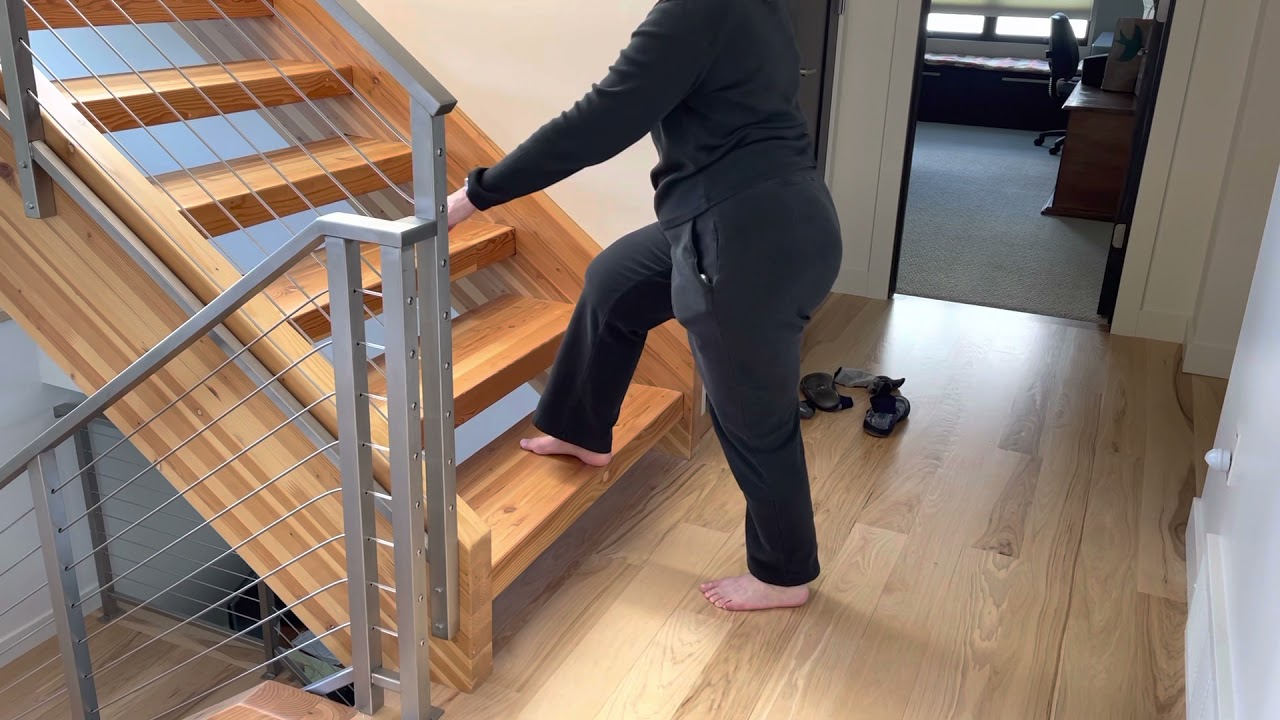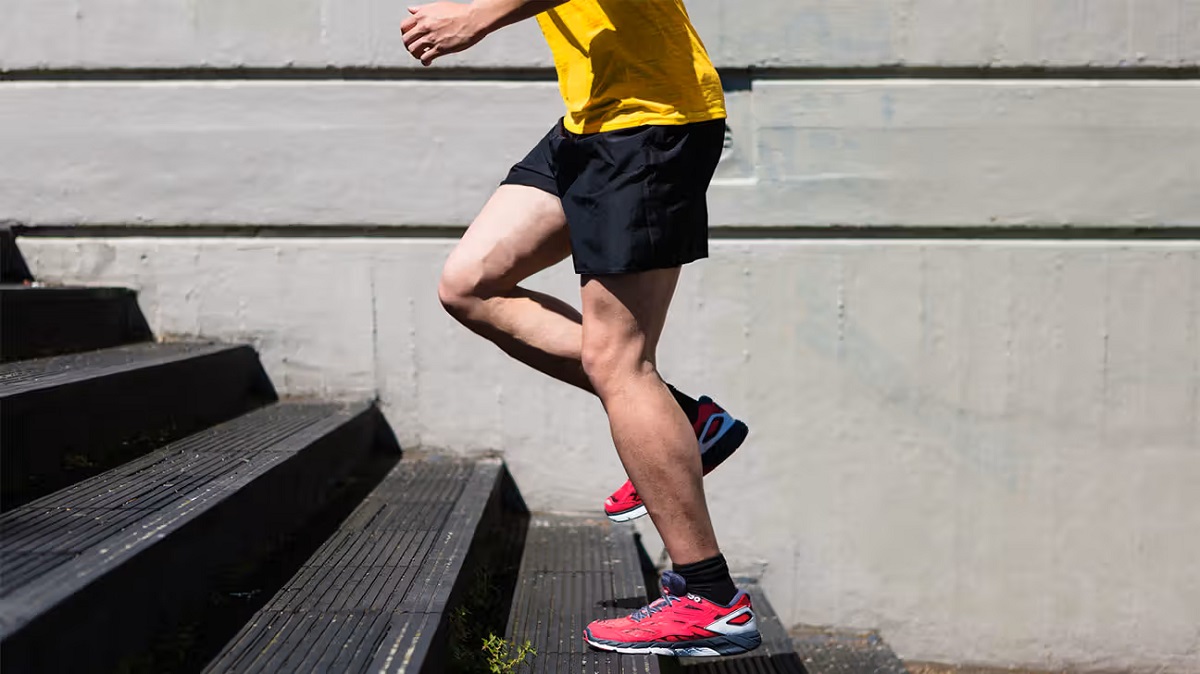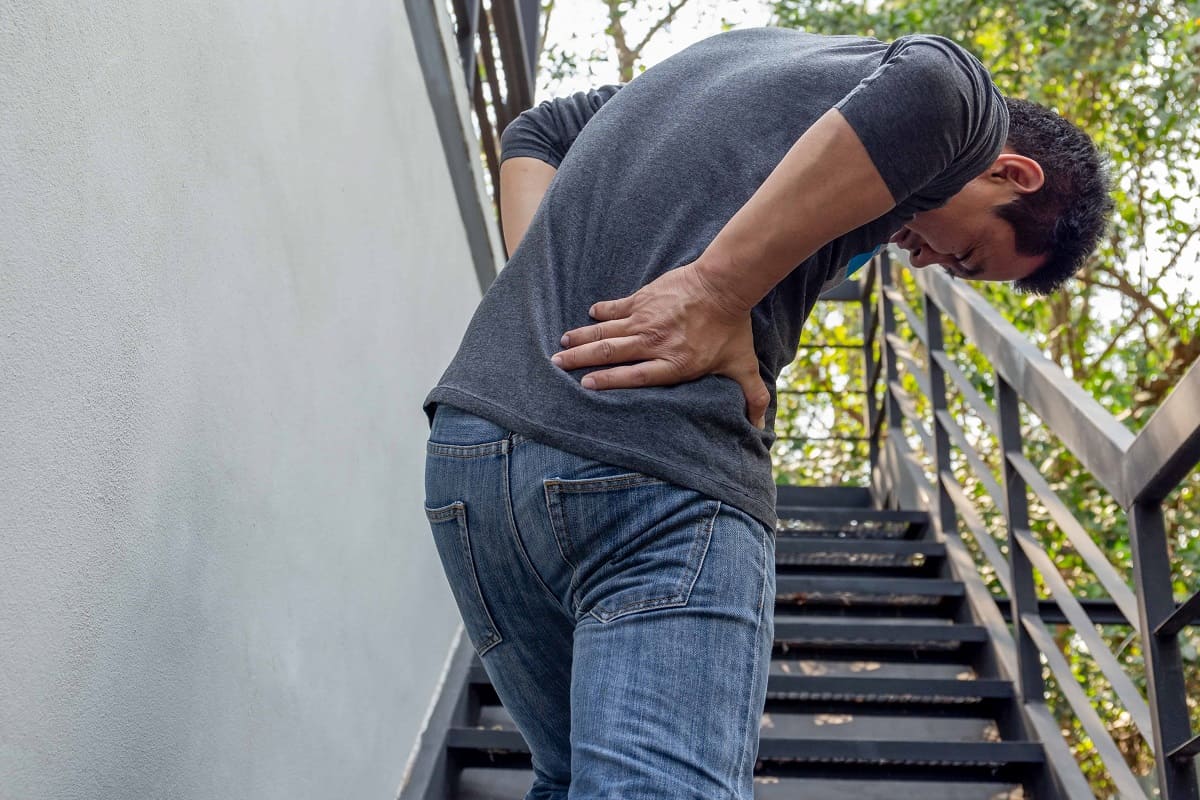Home>Articles>How Long After Hip Replacement Can You Climb Stairs


Articles
How Long After Hip Replacement Can You Climb Stairs
Modified: December 7, 2023
Discover how long after hip replacement you can safely start climbing stairs with our informative articles. Get expert advice and guidance on your recovery journey.
(Many of the links in this article redirect to a specific reviewed product. Your purchase of these products through affiliate links helps to generate commission for Storables.com, at no extra cost. Learn more)
Introduction
A hip replacement surgery is a common procedure that aims to alleviate pain and improve mobility in individuals suffering from severe hip joint damage or conditions such as osteoarthritis. Following the surgery, patients often wonder when they will be able to resume their normal activities, such as climbing stairs.
In this article, we will explore the recovery timeline after hip replacement surgery, factors that can affect the ability to climb stairs, and guidelines for safely climbing stairs post-surgery. We will also provide some exercises to help regain strength and mobility for stair climbing. Let’s dive in!
Key Takeaways:
- Regaining the ability to climb stairs after hip replacement surgery is a gradual process, influenced by individual factors and guided by healthcare providers. Patience, proper rehabilitation, and personalized guidance are key to a successful recovery.
- Following hip replacement surgery, climbing stairs safely and effectively requires gradual progression, proper technique, and adherence to rehabilitation guidelines. Open communication with healthcare providers and dedication to targeted exercises are essential for a successful return to stair climbing.
Understanding Hip Replacement Surgery
Hip replacement surgery, also known as total hip arthroplasty, involves replacing the damaged hip joint with a prosthesis. The surgery aims to relieve pain, improve functionality, and enhance the overall quality of life for individuals suffering from hip joint deterioration.
During the surgery, an incision is made and the damaged bone and cartilage are removed. The hip joint is then replaced with an artificial joint made of metal, plastic, or ceramic components. This new joint allows for smoother movement and reduced pain in the hip area.
Recovery Timeline after Hip Replacement Surgery
The recovery timeline after hip replacement surgery can vary from person to person due to factors such as age, overall health, and individual circumstances. However, there is a general timeline that indicates the expected progression of recovery:
- Immediate Post-operative Phase: Immediately after the surgery, patients are typically monitored in the recovery room and then transferred to their hospital room. Pain management measures are implemented, and physical therapy may begin to aid in the early mobilization of the joint.
- Week 1-2: During this period, patients will focus on healing and regaining strength. They may be required to use mobility aids, such as crutches or walkers, to assist with walking and maintaining balance.
- Week 3-6: At this stage, patients will gradually transition from using mobility aids to walking unaided. Physical therapy becomes more intensive to improve functional mobility and range of motion.
- Week 6-12: By this time, most patients experience significant improvement in pain relief and mobility. They may start to engage in light activities and specific exercises to regain strength and flexibility.
- 3-6 Months: Patients continue to progress in terms of strength, stability, and mobility. They may resume low-impact exercises and activities under the guidance of their healthcare provider.
- 6-12 Months: By this stage, patients are typically able to return to their normal activities, including climbing stairs, with minimal discomfort and improved functionality.
It is important to note that these timeframes are general guidelines, and each individual’s recovery journey may vary. Always consult with your healthcare provider to determine the most appropriate timeline for returning to specific activities.
Factors Affecting the Ability to Climb Stairs
Several factors can influence a person’s ability to climb stairs after hip replacement surgery. These factors include:
- Individual healing and recovery speed: Each person’s body heals and recovers at a different pace. Some may experience a quicker recovery and be able to climb stairs sooner, while others may require more time.
- Overall physical condition and muscle strength: The pre-existing physical condition and muscle strength of an individual can play a role in their ability to climb stairs. Stronger muscles and better physical fitness can facilitate the progression towards stair climbing.
- Presence of complications or comorbidities: Complications or other health conditions, such as obesity or cardiovascular issues, can affect the recovery process and delay the ability to climb stairs safely.
Considering these factors, it is crucial to follow the guidance of your healthcare provider to ensure a safe and successful recovery.
Key Takeaways:
- Regaining the ability to climb stairs after hip replacement surgery is a gradual process, influenced by individual factors and guided by healthcare providers. Patience, proper rehabilitation, and personalized guidance are key to a successful recovery.
- Following hip replacement surgery, climbing stairs safely and effectively requires gradual progression, proper technique, and adherence to rehabilitation guidelines. Open communication with healthcare providers and dedication to targeted exercises are essential for a successful return to stair climbing.
Understanding Hip Replacement Surgery
Hip replacement surgery, also known as total hip arthroplasty, is a surgical procedure commonly performed to alleviate pain and improve mobility in individuals suffering from severe hip joint damage or conditions such as osteoarthritis. This procedure involves replacing the damaged hip joint with a prosthetic implant, allowing for smoother movement and reduced pain in the hip area.
The hip joint is one of the largest weight-bearing joints in the body. It consists of the femur (thigh bone) and the acetabulum (socket) in the pelvis. Over time, due to factors like aging, overuse, injury, or conditions such as osteoarthritis, the hip joint can become damaged, leading to pain, stiffness, and decreased mobility.
Hip replacement surgery aims to restore the normal function of the hip joint, alleviate pain, and improve quality of life. During the procedure, an incision is made on the side or back of the hip, and the damaged bone and cartilage are removed. The surgeon then replaces the hip joint with an artificial implant made of metal, plastic, or ceramic materials.
The artificial implant consists of several components. The femoral component is a metal stem that is inserted into the thigh bone. It may have a metal or ceramic head that mimics the shape of a natural femoral head. The acetabular component is a cup-shaped piece that fits into the hip socket and is typically made of metal or ceramic. A liner made of plastic, ceramic, or metal is placed inside the acetabular component to allow for smooth movement.
The choice of materials for the artificial implant depends on various factors, including the patient’s age, activity level, and the surgeon’s recommendation. Metal-on-plastic implants are the most common type, as they provide good durability and reliability. Ceramic-on-ceramic implants have low wear rates and are a good option for younger, more active patients. Metal-on-metal implants are less commonly used due to concerns about metal debris and potential complications.
After the surgery, patients typically stay in the hospital for a few days for monitoring and initial rehabilitation. Physical therapy and exercises are initiated shortly after the surgery to aid in the recovery process, promote healing, and ensure proper alignment and functioning of the hip joint.
It’s important to note that hip replacement surgery is a major procedure that should be considered after all non-surgical treatment options have been exhausted. The decision to undergo hip replacement surgery should be made in consultation with an orthopedic surgeon who will evaluate the individual’s condition and recommend the most appropriate treatment approach.
Overall, hip replacement surgery has been proven to be a highly effective procedure for improving hip joint function and relieving pain. However, each case is unique, and the success of the surgery depends on various factors, including the individual’s overall health, post-operative care, and adherence to rehabilitation guidelines.
Recovery Timeline after Hip Replacement Surgery
The recovery timeline after hip replacement surgery can vary from person to person due to factors such as age, overall health, and individual circumstances. However, there is a general timeline that indicates the expected progression of recovery.
- Immediate Post-operative Phase: Immediately after the surgery, patients are typically monitored in the recovery room and then transferred to their hospital room. Pain management measures are implemented, and physical therapy may begin to aid in the early mobilization of the joint.
- Week 1-2: During this period, patients will focus on healing and regaining strength. They may be required to use mobility aids, such as crutches or walkers, to assist with walking and maintaining balance.
- Week 3-6: At this stage, patients will gradually transition from using mobility aids to walking unaided. Physical therapy becomes more intensive to improve functional mobility and range of motion.
- Week 6-12: By this time, most patients experience significant improvement in pain relief and mobility. They may start to engage in light activities and specific exercises to regain strength and flexibility.
- 3-6 Months: Patients continue to progress in terms of strength, stability, and mobility. They may resume low-impact exercises and activities under the guidance of their healthcare provider.
- 6-12 Months: By this stage, patients are typically able to return to their normal activities, including climbing stairs, with minimal discomfort and improved functionality.
It is important to note that these timeframes are general guidelines, and each individual’s recovery journey may vary. The duration of each phase can be influenced by factors such as the patient’s age, pre-existing health conditions, and the success of rehabilitation efforts. Additionally, some patients may experience a faster recovery and progress through the phases more swiftly, while others may require more time to achieve the desired level of recovery.
It is crucial to closely follow the instructions of the healthcare team regarding post-operative care, including carrying out prescribed exercises, attending physical therapy sessions, and avoiding activities that could potentially hinder the healing process. Open communication with the healthcare team is vital to address any concerns or complications that may arise during the recovery period.
While the recovery timeline provides a general framework, it is important to remember that every patient is unique, and individual circumstances may influence the progression and outcome of the recovery process. Patience, dedication to rehabilitation, and adherence to the healthcare team’s recommendations will go a long way in achieving a successful recovery after hip replacement surgery.
Factors Affecting the Ability to Climb Stairs
After undergoing hip replacement surgery, several factors can influence a person’s ability to climb stairs. Understanding these factors can help individuals manage their expectations and make necessary adaptations during the recovery period. Here are some key factors to consider:
- Individual healing and recovery speed: Each person’s body heals and recovers at a different pace. Some individuals may experience a quicker recovery and be able to climb stairs sooner, while others may require more time. It is important to consult with your healthcare provider to understand your specific recovery timeline.
- Overall physical condition and muscle strength: The pre-existing physical condition and muscle strength of an individual play a significant role in the ability to climb stairs post-surgery. Strong and well-conditioned muscles can aid in the recovery process and facilitate stair climbing. Engaging in appropriate exercise and physical therapy before and after surgery can help improve muscle strength and overall physical fitness.
- Presence of complications or comorbidities: Complications or other health conditions can impact the recovery process and delay the ability to climb stairs safely. Pre-existing health conditions, such as obesity, diabetes, or cardiovascular issues, can affect the healing process and may require additional care and caution during the recovery period.
- Age: Age can affect the recovery process after hip replacement surgery. Older individuals may experience a slower recovery compared to younger individuals due to factors such as decreased muscle strength and slower healing capacity. However, age alone should not deter individuals from attempting to climb stairs. With appropriate rehabilitation and guidance, individuals of all ages can regain their ability to climb stairs gradually.
- Post-operative rehabilitation: The proper implementation of post-operative rehabilitation plays a vital role in regaining the ability to climb stairs. Following the recommended exercise regimen and attending physical therapy sessions can help improve strength, flexibility, and balance, which are essential for safe stair climbing.
It is important to note that while these factors can influence the ability to climb stairs post-surgery, they should not discourage individuals from attempting to regain this skill. With proper guidance and effort, many individuals can progressively regain the ability to climb stairs and return to their normal activities.
Always consult with your healthcare provider and physical therapist to have a thorough understanding of your individual factors and how they may impact your ability to climb stairs. Your healthcare team can provide personalized guidance and recommendations based on your specific circumstances, ensuring a safe and successful recovery process.
When can you start climbing stairs after Hip Replacement Surgery?
One of the common questions individuals have after undergoing hip replacement surgery is when they can safely start climbing stairs. The ability to climb stairs depends on the individual’s recovery progress and varies from person to person. Here are some general guidelines to consider:
Consult with your healthcare provider: It is crucial to communicate with your healthcare provider to understand their specific recommendations for your recovery. They will assess your condition, monitor your progress, and provide guidance on when it is appropriate for you to start climbing stairs.
Short-term restrictions: In the immediate post-operative phase, it is common for healthcare providers to advise against climbing stairs. This is because the hip joint needs time to heal and stabilize. During this period, patients often use assistive devices like crutches or walkers and focus on regaining strength and mobility through targeted exercises and physical therapy.
Gradual progression: As you progress through the recovery stages, your healthcare provider may give you the green light to start climbing stairs. However, it is important to do so gradually and with caution. Initially, you may start by using a handrail for support and taking one step at a time. Over time, you can increase the number of steps and gradually reduce reliance on the handrail as you regain strength and stability.
Stair climbing timeline: The timeline for when you can start climbing stairs will generally align with the recovery stages following hip replacement surgery. Most individuals can begin stair climbing between six and twelve weeks after surgery, as long as they have attained sufficient muscle strength and stability. However, it is essential to remember that each person’s recovery is unique, so it is best to follow the guidance of your healthcare provider.
Individual factors: Factors such as age, overall health condition, and the presence of complications can also influence the timeline for stair climbing. Older individuals or those with pre-existing health conditions may require more time to regain their strength and confidence. It is important to be patient, listen to your body, and not rush the process of stair climbing.
Communication is key: Throughout your recovery journey, open communication with your healthcare provider is vital. Discuss any concerns, difficulties, or pain you may experience when climbing stairs. Your healthcare team will provide guidance and adjust your recovery plan accordingly to ensure your safety and well-being.
Remember, everyone’s recovery timeline is different, and the ability to climb stairs after hip replacement surgery is determined on an individual basis. It is important to follow the recommendations of your healthcare provider and listen to your body during the recovery process to ensure a safe and successful return to stair climbing.
Guidelines for climbing stairs post Hip Replacement Surgery
Regaining the ability to climb stairs is an important milestone in the recovery process after hip replacement surgery. However, it is essential to follow specific guidelines to ensure a safe and successful return to stair climbing. Here are some key guidelines to keep in mind:
1. Consult with your healthcare provider: Before attempting to climb stairs, it is crucial to consult with your healthcare provider for their approval and guidance. They will assess your progress, evaluate your strength and stability, and provide recommendations specific to your individual condition.
2. Start gradually: When you receive clearance from your healthcare provider, begin by practicing stair climbing gradually. Start by climbing a small number of stairs or even practicing on a single step. As you gain confidence and strength, gradually increase the number of stairs you climb.
3. Use handrails for support: Utilize handrails for added stability and support while climbing stairs. Hold onto the handrail with one hand and use the other hand to assist with balance. This will help distribute your weight evenly and reduce the strain on your hip joint.
4. Take it one step at a time: When climbing stairs, focus on taking one step at a time. Place your operated leg or the leg that underwent surgery on the step first, followed by your other leg. Take a moment to ensure your balance and stability before proceeding to the next step.
5. Mind your posture: Maintain good posture while climbing stairs. Keep your back straight, engage your core muscles, and avoid leaning forward or sideways. This will help distribute your weight properly and minimize strain on your hip joint.
6. Avoid overexertion: Be mindful of your energy levels and avoid overexertion while climbing stairs. Take breaks if needed and listen to your body’s signals. If you experience pain, discomfort, or excessive fatigue, pause and consult with your healthcare provider.
7. Wear appropriate footwear: Choose shoes that provide proper support and stability while stair climbing. Opt for shoes with a firm sole and good traction to prevent slips or falls. Avoid high-heeled shoes or shoes with a narrow base, as they can compromise your balance.
8. Follow your rehabilitation program: Continue with your prescribed exercises and physical therapy program to improve strength, stability, and range of motion. These exercises will help strengthen the muscles around your hip joint and enhance your ability to climb stairs with more ease and confidence.
9. Stay patient and listen to your body: Recovery after hip replacement surgery takes time, and each individual’s progress may vary. Be patient with yourself and don’t push beyond your comfort zone. Listen to your body’s cues and modify your stair-climbing routine as needed.
10. Seek guidance for any concerns: If you have any concerns, difficulties, or pain while climbing stairs, reach out to your healthcare provider. They can evaluate your situation, make any necessary adjustments to your recovery plan, and provide guidance to ensure your safety and well-being.
Following these guidelines and working closely with your healthcare provider will help you regain the ability to climb stairs safely and effectively. Remember, prioritize your recovery and take gradual steps towards reaching your goal of independent stair climbing.
Read more: When Can Puppies Climb Stairs
Exercises to Help Regain Strength and Mobility for Stair Climbing
After hip replacement surgery, performing specific exercises can help regain strength, stability, and mobility, enabling you to improve your ability to climb stairs. These exercises focus on strengthening the muscles around your hip joint and improving range of motion. Here are some exercises often recommended by healthcare professionals:
1. Quadriceps Sets: Sit on a chair with your back straight and your feet flat on the ground. Engage your thigh muscles by pushing your knees down into the chair. Hold for a few seconds, then release. Repeat this exercise 10-15 times to help strengthen the quadriceps muscles, which play a crucial role in stair climbing.
2. Straight Leg Raises: Begin by lying on your back with one leg extended and the other bent. Keeping the extended leg straight, slowly lift it a few inches off the ground. Hold for a few seconds, then lower it back down. Repeat 10-15 times for each leg. This exercise targets the hip flexor muscles, which are crucial for lifting your leg while climbing stairs.
3. Heel Slides: Lie on your back with both knees bent and your feet flat on the ground. Slowly slide one heel up towards your glutes while keeping the other foot grounded. Slowly return to the starting position and repeat with the other leg. Perform 10-15 repetitions for each leg. Heel slides help improve hip and knee mobility, which are essential for stair climbing.
4. Bridging: Lie on your back with your knees bent and feet flat on the ground. Engage your core muscles and lift your hips off the ground, forming a bridge position. Hold for a few seconds, then lower your hips back down. Repeat this exercise 10-15 times to strengthen the gluteal muscles, which support hip stability during stair climbing.
5. Side Leg Raises: Stand next to a sturdy support, such as a chair or wall, for balance. Lift one leg straight out to the side, keeping your toes pointing forward. Return to the starting position and repeat with the other leg. Aim for 10-15 repetitions on each side. Side leg raises target the hip abductor muscles, helping to improve stability during stair climbing.
6. Mini Squats: Stand with your feet shoulder-width apart and hold onto a stable surface for support, if needed. Slowly lower your body into a partial squat position, bending your knees while keeping your back straight. Hold for a few seconds, then rise back up. Aim to perform 10-15 repetitions. Mini squats help strengthen the quadriceps, hamstrings, and gluteal muscles, which are all involved in stair climbing.
7. Step-Ups: Find a stable step or platform at a manageable height. Step onto the platform with one foot, pushing through your heel, and lift your body up onto the platform. Step back down and repeat with the other foot. Perform 10-15 step-ups on each leg. This exercise mimics the motion of stair climbing and helps improve strength and balance.
8. Calf Raises: Stand upright with your feet hip-width apart, holding onto a stable surface for balance. Slowly rise up onto your toes, lifting your heels off the ground as high as you can. Hold for a moment, then lower your heels back down. Complete 10-15 repetitions. Calf raises strengthen the calf muscles, which contribute to stability and propulsion while climbing stairs.
Always consult with your healthcare provider or physical therapist before starting any exercise program after hip replacement surgery. They can provide personalized guidance, ensure correct technique, and recommend modifications based on your specific needs. Over time, as you consistently perform these exercises, you will regain strength, improve mobility, and increase your ability to climb stairs confidently.
Precautions and Considerations while Climbing Stairs Post Hip Replacement Surgery
After undergoing hip replacement surgery, it is important to take certain precautions and considerations while climbing stairs to ensure a safe and successful recovery. Here are some important guidelines to keep in mind:
1. Follow your healthcare provider’s instructions: Always adhere to the instructions and recommendations provided by your healthcare provider regarding stair climbing. They are familiar with your unique situation and can provide specific guidance based on your condition and progress.
2. Start with the easier direction: When initially returning to stair climbing, it can be helpful to start with the easier direction, meaning ascending or descending with your non-operated leg first. This can help build confidence and allow you to focus on your technique and balance.
3. Utilize handrails for support: Whenever possible, use handrails for added support and stability while climbing stairs. Holding onto the handrail with one hand can help maintain balance and prevent falls. Make sure the handrail is securely fastened and in good condition.
4. Take your time and pace yourself: Avoid rushing or hurrying when climbing stairs. Take your time and climb at a comfortable and controlled pace. This will help prevent unnecessary strain on your hip joint and reduce the risk of accidents or falls.
5. Use proper stair-climbing technique: Maintain good posture while climbing stairs by keeping your back straight and core engaged. Focus on placing your whole foot on each step, distributing your weight and ensuring stability. Avoid leaning forward or sideways, as it can compromise your balance.
6. Avoid carrying heavy loads: While you are recovering from hip replacement surgery, it is advisable to avoid carrying heavy objects or loads while climbing stairs. Heavy loads can put additional strain on your hip joint and increase the risk of injury or instability. If necessary, ask for assistance or find an alternative way to transport heavy items.
7. Be mindful of uneven or slippery surfaces: Pay attention to the condition of the stairs you are climbing. Watch out for any uneven surfaces or loose steps. Ensure that the stairs are clean and free from debris or liquids that could make them slippery. If you encounter any unsafe conditions, proceed with caution or seek an alternate route if available.
8. Communicate any discomfort or concerns: If you experience pain, discomfort, or swelling in your hip or have any concerns while climbing stairs, communicate with your healthcare provider. They can evaluate your situation, provide guidance, and make any necessary adjustments to your recovery plan.
9. Gradually increase intensity and duration: As you progress in your recovery, gradually increase the intensity and duration of your stair-climbing activities. Start with shorter flights of stairs and then gradually increase the number of steps or tackle longer staircases. This gradual progression allows your muscles and joints to adapt and become stronger over time.
10. Stay consistent with your rehabilitation program: Continue to follow your prescribed exercise and rehabilitation program to maintain and enhance the strength and mobility of your hip joint. These exercises will not only assist in your stair-climbing ability but also contribute to overall recovery and long-term joint health.
Remember, every individual’s recovery is unique, and it is important to listen to your body and respect your limitations. Following these precautions and considerations will help to minimize risks, maximize your chances of a successful recovery, and ultimately regain your ability to climb stairs with improved confidence and comfort.
Conclusion
Hip replacement surgery is a life-changing procedure that can significantly improve pain, mobility, and quality of life for individuals with hip joint damage or conditions such as osteoarthritis. As part of the recovery process, regaining the ability to climb stairs is a common goal for many patients.
Throughout this article, we have explored important aspects of climbing stairs after hip replacement surgery. We discussed the overall recovery timeline and factors that can influence the ability to climb stairs. We also provided guidelines for stair climbing post-surgery and highlighted exercises to help regain strength and mobility.
We emphasize the importance of consulting with your healthcare provider for personalized guidance and recommendations. They will monitor your progress, assess your specific condition, and advise you on when it is appropriate to start climbing stairs. Always follow their instructions and communicate any concerns or difficulties you may encounter.
When beginning stair climbing, start gradually and utilize handrails for added support. Take your time, listen to your body, and be aware of proper technique and posture. It is crucial to pace yourself, avoid overexertion, and be mindful of potential hazards such as uneven or slippery surfaces.
Participating in a structured rehabilitation program and performing targeted exercises can greatly aid in the recovery process. Strengthening the muscles around your hip joint and improving your range of motion are key to regaining confidence and stability while climbing stairs.
Remember, each person’s recovery journey is unique. Patience, perseverance, and consistency in following the prescribed exercises and rehabilitation program are essential. Most importantly, prioritize your safety and well-being throughout the recovery process.
In conclusion, climbing stairs after hip replacement surgery is a gradual and achievable goal. With proper guidance, patience, and a focus on rehabilitation, individuals can regain their ability to climb stairs and return to their normal activities. Trust in the expertise of your healthcare team, embrace the recovery process, and celebrate your achievements along the way.
Frequently Asked Questions about How Long After Hip Replacement Can You Climb Stairs
Was this page helpful?
At Storables.com, we guarantee accurate and reliable information. Our content, validated by Expert Board Contributors, is crafted following stringent Editorial Policies. We're committed to providing you with well-researched, expert-backed insights for all your informational needs.














0 thoughts on “How Long After Hip Replacement Can You Climb Stairs”